




An Introduction to How Crystals are Formed
Crystal is a certain kind of solid object. All matter around us is made up of tiny particles called atoms and molecules. If these atoms or molecules are arranged in a regular pattern then the object is called a crystal. The process of formation of crystals is called crystallisation. Crystals are a special kind of solid material in which the molecules fit with each other in a repeating order. That is why they have unique shapes. Crystals are sparkling, shimmering, soft and silky solid materials. They have many shapes and colours. Read ahead to learn more about crystals and their formation.
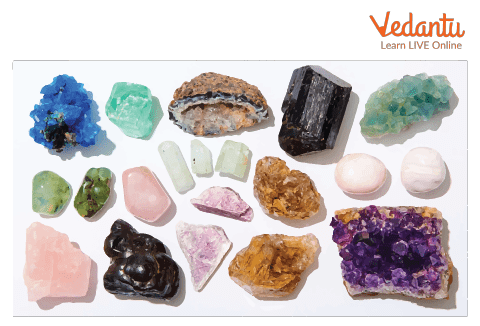
Various Kinds of Crystals
How Are Crystals Formed?
A crystal is a solid material that consists of a three-dimensional arrangement of atoms, molecules and ions. The process of formation of crystals is called crystallisation. Crystals are not like biological systems which nourish from the inside, they grow from the outside by any of the following three methods.
Either from a vapour
Either from a melt
Either from a solution
It is a three-step process
It begins with a process called nucleation in which molecules systematically approach each other to form some stable aggregates.
The second step in the process is growth. In this step, there is the addition of more molecules or atoms to the surface of the crystal regularly.
The third and last step is called termination. In this step, growth stops further and molecules lay down at the crystal surface.
Unique Properties of Crystals
Let us learn some unique properties of crystals.
Crystals have flat surfaces and these surfaces are called facets. They can form geometric shapes such as triangles, rectangles and squares.
Their shapes are due to different types of atoms or molecules present in them.
There are seven different shapes of crystals which are called lattices. These shapes are cubic, trigonal, triclinic, hexagonal, orthorhombic, monoclinic and tetragonal.
Crystals differ in physical properties for example hardness, heat conductivity, and electrical conductivity.
Interesting Types of Crystals
There are various types of crystals. Let us talk about some of them.
1. Snowflakes: These are ice crystals. They are formed high in the clouds when water freezes. These crystals have six sides and every one of them is unique.

Snowflake Crystals
2. Timing Crystals: In some crystals when an electric current is passed, they vibrate at a very precise frequency. Quartz crystals are used to keep an accurate time in watches and other electronics.
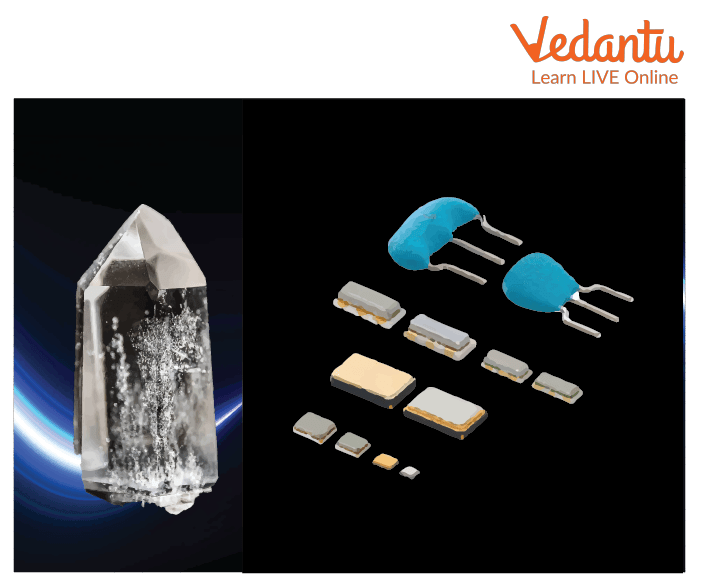
Crystal Timing Devices
3. Quartz: It is a common crystal and one of the hardest common minerals.
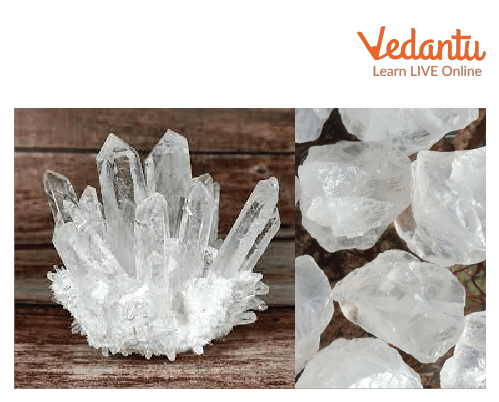
Quartz Crystal
4. Diamond: Diamonds are one of the most valuable minerals and one of the hardest substances on earth.
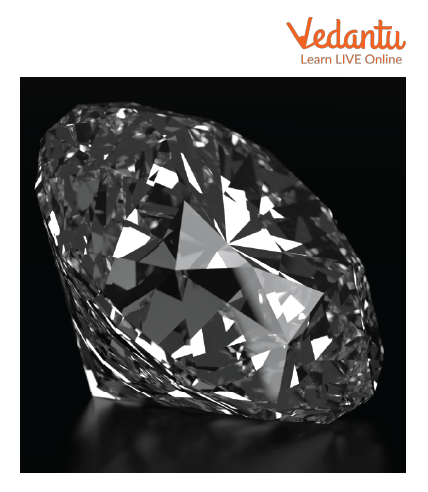
Diamond Crystal
How to Make a Crystal?
Let us learn how to make a crystal. First of all what we need to make a crystal is magnesium sulphate, which is a salt, food colouring pack and a 250 ml beaker.
The steps involved in making crystals are:
Firstly, in a beaker take half a cup of magnesium sulphate with a half cup of very hot water and stir it for at least 1 minute so that a saturated solution is prepared which means no more salt can be dissolved in the water.
Add a few drops of food colouring so that crystals get coloured.
Put the beaker in the refrigerator for a few hours. After a few hours, a beaker full of crystals can be observed. Crystals grown in this manner are of small size, thin and numerous.
Sample Questions
Question 1. What are crystals made of?
Ans: A crystal is made up of atoms of the same element or atoms of different elements which are arranged regularly.
Question 2. How fast do crystals grow?
Ans: Crystals can grow about two centimetres for ten million years. In mines, they can even grow faster.
Question 3. What is a group of crystals called?
Ans: A group of crystals is called lattice systems. Each lattice system consists of three axes in a particular arrangement.
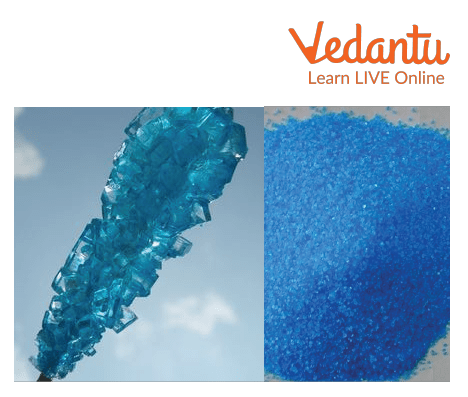
Blue-coloured Crystals are Formed from Magnesium Sulphate
Summary
Crystals are minerals that hold energy and as we humans are made up of energy we can exchange energy with the crystal when we work with it. They improve the functions of many everyday objects like watches, plugs, hospital equipment, lasers and other electronic devices. Many people use crystals to heal physical illnesses while others use these for focus and stress.
FAQs on How are Crystals Formed?
1. What is the definition of a crystal in science?
In science, a crystal is a solid material where the atoms, molecules, or ions are arranged in a highly ordered, repeating three-dimensional pattern. This internal structure, known as a crystal lattice, is what gives crystals their characteristic flat faces and specific geometric shapes. Common examples you might know are salt, sugar, and snowflakes.
2. What is crystallisation and how does it happen?
Crystallisation is the process by which a solid forms, with its atoms or molecules arranging themselves into a structured crystal lattice. It most often occurs in two ways: when a liquid cools and solidifies (like water freezing into ice), or when a substance precipitates from a supersaturated solution. As the solution cools or the solvent evaporates, the solute particles come closer, bond together, and organise themselves into a stable, repeating pattern.
3. What are some common materials used to grow crystals at home?
You can easily grow crystals at home using simple, safe materials. The key is to use a substance that dissolves well in water to create a saturated solution. Good examples include:
- Sugar (Sucrose): Dissolved in hot water to make rock candy.
- Salt (Sodium Chloride): Simple table salt can be used to grow small cubic crystals.
- Epsom Salt (Magnesium Sulfate): Creates needle-like crystals.
- Borax: A laundry booster that forms large, clear crystals quickly as a hot solution cools.
4. Can you explain the step-by-step process for forming sugar or salt crystals?
Yes, here is a simple step-by-step guide to growing your own crystals:
- Step 1: Create a Supersaturated Solution. Heat water and stir in salt or sugar until no more will dissolve. This solution now contains more solute than it can normally hold at room temperature.
- Step 2: Prepare for Growth. Pour this hot solution into a clean jar. Hang a string or a popsicle stick so it dangles in the middle of the solution, which will act as a surface for the crystals to grow on.
- Step 3: Cool and Evaporate. Place the jar in a location where it can remain undisturbed. As the water cools and slowly evaporates, the dissolved particles will begin to form on the string.
- Step 4: Watch them Grow. Over several days, these initial seed crystals will attract more particles and grow larger, revealing their natural shape.
5. What factors can affect the size and shape of a growing crystal?
Several factors influence how a crystal grows, affecting its final size and quality. The main ones are:
- Rate of Cooling: Slow cooling of a solution or magma allows more time for molecules to arrange themselves, typically resulting in larger, more perfect crystals. Rapid cooling creates many small crystals.
- Concentration: A solution with a higher concentration of dissolved material (supersaturated) provides more building blocks for crystal growth.
- Evaporation: A faster rate of evaporation concentrates the solution more quickly, which can speed up crystal formation.
- Pressure: In nature, extremely high pressure can force atoms into a crystalline structure, which is how diamonds are formed from carbon deep within the Earth.
6. How are crystals formed in nature, like in caves or rocks?
In nature, crystals form over very long periods through geological processes. For instance, in caves, water rich in dissolved minerals like calcite seeps through rock. As the water drips and evaporates, it leaves behind the mineral deposits, which build up over thousands of years to form large crystal structures like stalactites. In igneous rocks, crystals form when molten rock (magma) cools. If it cools slowly underground, large mineral crystals have time to develop, creating rocks like granite.
7. Why do different crystals, like salt and sugar, have completely different shapes?
The unique shape of a crystal is a direct reflection of its internal atomic arrangement, or crystal lattice. Each substance has a unique way its atoms bond and stack together. Salt (sodium chloride) atoms form a simple cubic lattice, which is why salt crystals are shaped like tiny cubes. Sugar molecules are larger and more complex, so they pack together to form flat, slanted shapes known as monoclinic crystals. The outer shape of the crystal is an expression of this invisible, orderly internal pattern.
8. What is the importance of a 'saturated solution' in crystal formation?
A saturated solution is crucial because it is the starting point for crystallisation. It is a solution where the maximum possible amount of a substance (solute) has been dissolved. To actually grow crystals, you typically need to create a supersaturated solution—one that is forced to hold more solute than it normally can, usually by heating it. This state is unstable. As the solution cools or evaporates, it can no longer hold the excess solute, which then precipitates out and forms solid, organised crystals to return to a stable state.
9. Do crystals need light to grow, or can they form in the dark?
No, light does not affect crystal growth. The formation of crystals is a physical process governed by factors like temperature, concentration, and pressure. It is not a biological process like photosynthesis. Crystals can and do form perfectly well in complete darkness, which is demonstrated by the massive crystal formations found deep inside caves and underground mines, far from any sunlight.
10. What is the main difference between a crystal and a common rock?
The key difference is their internal structure. A crystal is a single, uniform substance with an orderly, repeating arrangement of atoms throughout. This gives it a defined geometric shape. In contrast, a rock is typically a mixture or aggregate of different minerals. While a rock like granite contains many small crystals of minerals like quartz and feldspar, the rock itself does not have a single, unified crystal structure. It is a composite material.









